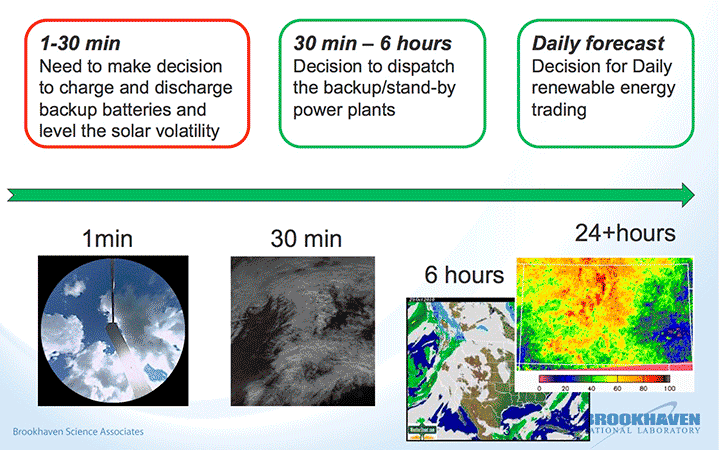Computational Science Laboratory Projects
DOE EERE SunShot Project
Multi-Scale Prediction of Photovoltaic System Performance for Smart Grid Integration
Changes in atmospheric transmissivity caused by clouds can engender fluctuations in photovoltaic (PV) outputs that are far larger than the typical power fluctuations from traditional power plants. A robust prediction model has to address the cloud effects, utilize different instrumentations and datasets from total sky imager (TSI) and satellites, and generate prediction results with different time scales. Our preliminary studies and the following research work are funded by DOE proposal “A Public-Private-Academic Partnership to Advance Solar Power Forecasting” (March/12/2013-March/11/2016, Dantong Yu, Computational and Model Development lead). We target at seminal advances in the state of cloud forecasting, and thus, solar irradiance and power forecasting. All these effort will facilitate the solar power integration into the grid and assess the resulting value. This work will thereby improve solar energy to be more efficient, economical, sustainable, and reliable and advance its penetration into the routine power consumption.
In particular, we build two forecast models: one is based on images from a network of TSIs and other ground-based optical techniques, and the other one is based on satellite images that is particularly suitable for large-scale cloud systems. No existing weather model offers atmospheric transmissivity forecasting at such detailed time and space resolution. We address the challenging issues in computer engineering in choosing cost-effective input datasets among various data sources based on the required granularity of prediction times. Such a multi-scale predication model matches a series of existing problems in integrating volatile energy sources (such as Solar and Wind turbine) into the smart grid. The prediction system can be incorporated directly into BNL’s 32-megawatt solar array built and operated by BP Solar to monitor radiation variation, predict electricity output at a new level of detail, and address issues of integrating large-scale solar panel operations into the power grid.

Proposed forecast system based on TLI
Selected Publications
Z. Peng, D. Yu, D. Huang, et al., 3D Cloud Detecting and Tracking System for Solar Forecast Using Multiple Sky Imagers, Solar Energy (2015).
Z. Peng, S. Yoo, Dantong Yu, D. Huang, P. Kalb, and J. Heiser, 3D Cloud Detection and Tracking for Solar Forecast using Multiple Sky Imagers, the 29th Symposium On Applied Computing (SAC'14) March 24-28, 2014, Gyeongju, Korea.
Z. Peng, S. Yoo, D. Yu, and D. Huang, Solar Irradiance Forecast System Based on Geostationary Satellite, IEEE International Conference on Smart Grid Communications, Oct/2013, Vancouver, Canada.
H. Huang, J. Xu, Z. Peng, S. Yoo, D. Yu, D. Huang, H. Qin, Cloud Motion Estimation for Short Term Solar Irradiation Prediction, IEEE International Conference on Smart Grid Communications, Oct/2013, Vancouver, Canada




